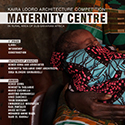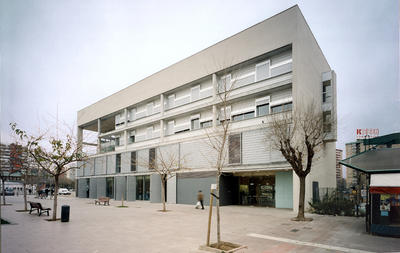PROGETTI >> REALIZZATI
DAY CENTER AND HOUSING
PROGETTISTA: Jordi Farrando Jordi Farrando, arquitecte
- Year:: 2004
- Category:: Altro
- Customer:: Welfare Dept., Catalan gov.
- Viewed: 790 TIMES
DESCRIZIONE: Site description
The building is located in the district of Bellvitge, in L’Hospitalet de Llobregat. The site measures 38.33 x 15 m, with its...
Site description
The building is located in the district of Bellvitge, in L’Hospitalet de Llobregat. The site measures 38.33 x 15 m, with its longest sides facing almost due east and west, and the shorter sides facing north and south. It is a noticeably even site, with very few centimetres of height difference between its various points. It is currently empty, with no construction of any kind.
The buildings around it are characteristic of this part of L'Hospitalet: 13-floor apartment blocks in a parallel layout with auxiliary two-storey buildings to accommodate commercial activity and a few more specific constructions for other uses. The closest construction is the Telefónica building, which stands 15 metres to the south. To the east and north, it borders a sports facility currently in disuse, and the western side overlooks a pedestrian avenue.
The site enjoys a strategic position in relation to pedestrian routes through the district, as it stands at the intersection of the landscaped area around one of the Metro exits of Bellvitge station and the paved esplanade that leads to the market.
There are numerous parking places around this landscaped area, though the future building’s immediate setting is pedestrian. Although the nearest traffic to the building is strictly local, the proximity of the Rambla Marina facilitates connection with the city’s main thoroughfares.
Entrance to the social centre is via a porch that stands back from the street, leading into the foyer. It contains the caretaker’s office and the storeroom. The caretaker’s office forms part of a block that houses the ground floor washrooms, so access to the multipurpose hall takes place via a filter.
The multipurpose hall is open plan, overlooking the pedestrian space of the avenue beyond and allowing a free relation between the users of this space and the rest of the neighbourhood; in the summer, a terrace can be set up outside. On the north side, overlooking the paved esplanade that leads to the market, a large window provides visual contact between users of the hall and the exterior. The multipurpose hall therefore organizes the building’s most active spaces with the busiest areas of the city around it.
The eastern sector of the ground floor houses the day centre’s catering programme (kitchen, cafeteria, storeroom, larder, refuse and staff changing rooms). These spaces have an independent entrance from the exterior which is entirely independent of the rest of the building’s activities. The cafeteria and the kitchen exit establish contact with the spaces of the multipurpose hall.
This bay also contains space for vehicle parking, which is accessible directly from the outside, and the TV-stage set, raised 45 cm above the level of the rest of the floor and spatially connected with the multipurpose hall, leading to the dressing room. There is also an exit to the small garage, so that materials can be unloaded from the car park if necessary without affecting other communal areas of the day centre.
The rest of the day centre’s public spaces (halls, gym, offices, etc.) are situated just above the multipurpose hall, giving onto the west façade, with access provided by a passage running right through the centre of the building. The top part of the partitions between the activity spaces and the corridor are glazed to allow light to shine in. A double-height slit also promotes interrelation between the through areas on the ground and the first floors. This slit accommodates a stairway that allows users of the day centre to change level without leaving the public areas. The offices and washrooms are the elements located nearest the entrance to the stairway.
Project description
There are two parts to the programme: sheltered dwellings for 24 residents and a day centre for the elderly.
The ground floor and half of the first floor are occupied by the day centre, and the sheltered dwellings occupy the rest of this floor and levels two and three.
One of the client’s basic requirements was to allow the building’s two programmes to function independently. The two foyers, though adjacent and communicable, therefore each have an independent entrance from the street. The day centre entrance is in the southern edge of the west façade and the street door to the dwellings is at the bottom of the opposite façade.
Given the project’s urban implantation, it seemed appropriate to situate the public part of the day centre’s programme in the west façade, overlooking the landscaped area that extends as far as Rambla Marina and bordering the pedestrian promenade. For this reason, of the two lengthwise bays into which each of the floors is divided, it is the west bay that accommodates the multipurpose hall (ground floor) and the programme of reading room, classroom-workshop, hairdresser’s, chiropodist, gym, computer room and offices (first floor).
The service areas of the day centre (kitchen, larder, refuse, cafeteria, staff changing rooms, etc.) are situated in the east bay on the ground floor, adjacent to the disused sports field and, therefore, away from the activity of the street. On the first floor, the east bay is occupied by the services of the sheltered dwellings (laundry-sewing room, maintenance and storage, kitchen, installations, etc.).
The actual dwellings occupy the second and third floors in their entirety.
The entrance to the sheltered dwellings is in the south of the east façade and, as needed, via the doorway of the day centre. The stairway and lift in the entrance nucleus are the only elements in the housing programme to be located on the ground floor.
On the first floor, the east bay accommodates the service spaces for this part of the programme (kitchen, larder, refuse, cafeteria and staff changing rooms), joined by a corridor that runs the length of the building’s east façade and, therefore, totally independent of the areas of the day centre on the same floor. Once again, the foyers of the two parts of the programme that share the first floor are adjacent so that they can be connected or left completely independent, as decided by the management.
The second and third floors respond to a similar layout. Both are occupied by sheltered dwellings.
Starting at the entrance foyer, where the stairway and lift are located, a central corridor forms the backbone of the floors. On the west side there are seven individual practicable dwellings and, in the east, one double and three individual accessible apartments. In the northwest of each floor, there is a living room that could also be used as a resident dining room. On the second floor, the living room opens up onto a terrace in the building’s west façade; on the third floor, it overlooks the double exterior space created above this terrace. The two superposed lounges are also interrelated by a small double space.
Each of the individual dwellings has a washroom, a small kitchen and a living-cum-bedroom. The washrooms and kitchens are laid out along the central corridor, freeing up the façades for living spaces. This not only makes the most of views and lighting, it also rationalizes the distribution of installations. In order to comply with regulations governing habitability in spaces containing toilets and kitchens, in all cases there are two doors between them.
The roof is accessible from the vertical communications shaft of the sheltered dwellings, which also contains the vertical distribution of the building’s installations. The installations machinery is situated on the part of the roof nearest this shaft.
















































